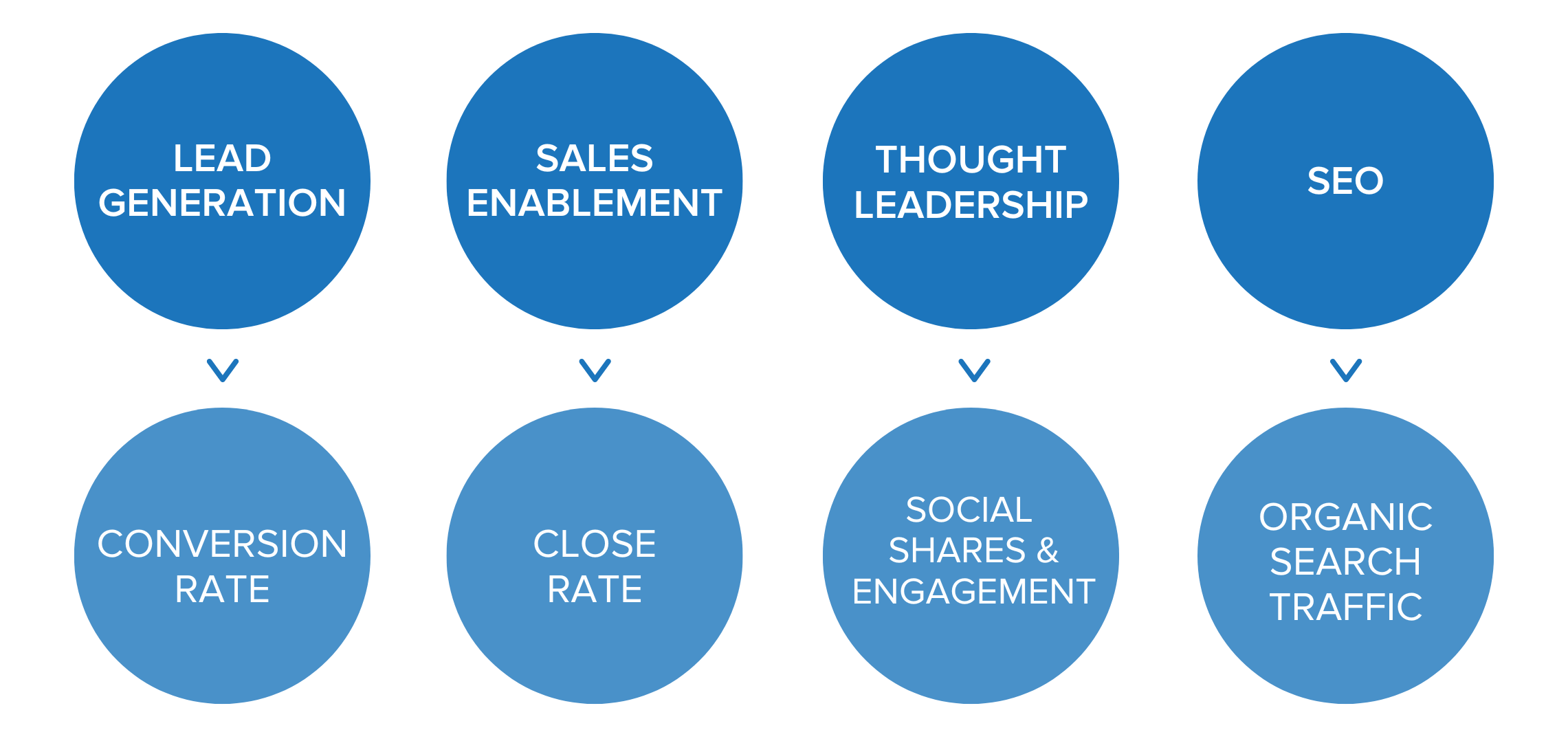
How to Create a Documented Content Strategy That Works
How to Create a Documented Content Strategy That Works
Kelsey Raymond, COO • Intero Digital • December 22, 2021

By now, it’s common knowledge that a documented content strategy is essential for content marketing success. Content Marketing Institute surveys marketers across industries every year, and time and time again, it reports that a majority of the most effective marketers have a documented strategy. In its most recent report, CMI found that 62% of the most successful content marketers have a documented content marketing strategy in place.
It’s true that just having a strategy doesn’t guarantee results. (If only it were that simple!) But it does contribute to a high-performing team whose members work toward the same goals — and that’s powerful.
The Value of a Documented Content Strategy
Our team at Intero Digital can attest to the value of a documented strategy. In fact, ours has helped us nurture and close millions in revenue, as well as achieve other goals.
Content strategies are critical to success, yet too many marketers drag their feet when it comes to creating one of their own. Some marketing leaders don’t see the value in taking time to write down a plan when a verbal understanding seems sufficient; others would rather skip that step entirely and dive into creating content.
On the surface, these are understandable objections, but they’re also short-sighted. Content marketing is a long-term game, and that requires commitment and advanced planning — in other words, a comprehensive plan. A documented content strategy can help you:
- Establish your content marketing goals.
- Define and measure your success.
- Develop and refine your editorial process.
- Properly align your team members.
- Hold everyone accountable.
- Set up your team to scale and ensure it grows in the right direction.
The benefits of content marketing and a documented strategy to guide it are clear. Unfortunately, there’s a big difference between understanding that a plan is important and actually putting one together.
In this guide, Intero Digital will teach you how to develop a content strategy that works for your company and its objectives.
How to Develop a Content Strategy That Works for Your Company
1. Document your overall mission and your “why.”
Documenting your mission and explaining why your company is making an investment in content is an essential first step. Not only does it guide the development of the rest of your strategy, but it can also help make the case for content marketing to other leaders within your company.
Anyone from sales to account services to HR should look at this strategy and understand why content is a priority. To get the most complete picture of your mission, ask yourself and your team questions like:
- Why are we investing our time, money, and human resources in content?
- Who are we using content to engage?
- How does this contribute to our goals or mission as a company? As a marketing department?
- How will we know whether we’re successful?
2. Define your goals and KPIs.
The earlier in your content marketing journey you can identify your goals, the easier time you’ll have when it comes to measuring content marketing ROI and improving your strategy over time.
Unfortunately, accurately measuring content’s impact is a challenge for a lot of marketers. While there’s no one-size-fits-all solution for tracking ROI, there is a first step all marketers can take: aligning metrics and goals.
Following your mission statement, take time to clearly define your content objectives and the KPIs that will tell you whether you’re on the right track. The image below provides some examples:

3. Create data-driven audience personas.
Now that you know why you’re creating content in the first place, it’s time to identify who your audience is and develop data-driven personas.
You might be thinking: “Wait a minute. Didn’t I already identify my audience when I put together my mission?”
The answer is technically yes — but that answer probably won’t be detailed enough. Knowing who your customers are and understanding their wants and needs is probably the most important element of your documented content strategy. This ultimately determines what sort of content you want to create so you can really speak to and engage your audience.
The first step is to do a little research. One great way to start is to trace the online journeys of some of your current customers. Make a list of a few of your best clients and walk through their journeys. How did they first learn about your company? What content did they consume on your site? What messaging resonated with them?
You can find a lot of this information in your customer relationship management system, but take it a step further and consult those clients’ salespeople, too. What was the sales process like? What were those clients most excited about, and what were their biggest objections? This information gives you a peek at the decision-making process of the people who chose to work with you.
In addition, start developing profiles of ideal audience members. Who are you speaking to? What are their roles or positions within the company? What motivates them? Putting yourself in your audience members’ shoes can help you create an engaging content experience for them. Take the time to do that when you develop personas.
4. Plan a diverse content mix.
With a solid understanding of why you’re creating content and who you’re creating it for, it’s time to assess what kind of content you’ll create. Before your team sets out to reinvent the wheel, take stock of your current content assets.
A simple content audit will let you know what you already have, what needs to be refreshed, and what gaps exist in your content. Don’t worry — an audit doesn’t have to be majorly comprehensive or time-consuming.
Simply start by pulling your blog content and organizing it into a spreadsheet. (Tools from Screaming Frog or Semrush can make this easy.) Include filters that organize your content by category or topic, publish date, etc., and incorporate data points such as views and conversions if you’d like.
From there, analyze what you’re working with by asking the following questions:
- What topics do you have a lot of content about?
- Are there any topics your audience is interested in that you haven’t created content for?
- How are various topics and formats performing?
- Do you see more opportunity in refreshing older content or creating all-new content?
- What types of content do you need: written articles, videos, infographics, whitepapers?
This kind of data can help you find a starting point in your content mix — at least in your owned media. Don’t overlook the power of bringing your owned media together with earned media, like guest-contributed content and press mentions, and paid media. Incorporating your approach to earned and paid media into your content mix is critical for getting a comprehensive view of your content plan.
The most important thing here is that you and your team consider the variety of media your audience needs to stay engaged and move through your marketing funnel.
5. Develop an editorial workflow and process for content creation.
Depending on the size of your content marketing team, this element of your plan will likely be the most tactical and involve the most nitty-gritty specifics. With all the other details of your content strategy in place, it’s time to figure out how you’ll execute it.
At Intero Digital, we understand that effective content marketing requires the right talent and the right technology. Your process is the particular way your team and tools work together, and your content plan should detail it.
Start by identifying your content’s key players and their responsibilities; include your in-house team members and any vendor or partner relationships you currently have or plan to build. Next, list the technology these team members need to do their best work, and outline your editorial workflow — that is, the way these people and tech work together to ideate, create, and distribute your content.
6. Put together a distribution plan.
If you put together a content strategy without also detailing a distribution plan, you’re going to have a bad time. That’s because without a distribution plan, the content you’ve spent so much time creating won’t reach the right people at the right time.
So how can you ensure the audience you’re targeting even sees your content? A good way to start is to create a social distribution plan to share your content on the platforms your audience loves and trusts.
But you can’t stop there. You have a ton of unique tactics and platforms at your fingertips that you can use to distribute your content — you just have to get creative. Here are some examples to help get you started:
- Email newsletters
- LinkedIn groups
- Quora
- Medium
- External publications
- Employee networks
- Client/partner networks
Obviously, you can’t copy and paste your plan and apply it to everything, but knowing from the start how you intend to distribute a piece of content can help you move more quickly to actually do so once it’s live. It helps keep your team focused on the true value of distribution instead of making it an afterthought.
You can also use this area of your content strategy to outline any distribution guidelines your team needs to be aware of. This could be anything from your highest-priority social platforms and the standards you use when you share content to email campaign goals, audience segments, and online community guidelines.
7. Establish an editorial calendar.
This is one of the last steps a strategy needs to detail. Now, you obviously can’t determine your exact cadence or what you’ll publish for the whole year in one sitting. What you can do to guide your efforts, though, is think through an overall publishing schedule that aligns with your goals.
Start thinking about how much content — and what kinds of content — you need to produce each month to achieve your objectives. How many blog posts do you need? What about guest posts in external publications? How often will you produce new gated content, videos, or webinars?
Start writing it down now, and adjust as needed throughout the year. This calendar isn’t a hard-and-fast commitment, but it can give you and your team a visual idea of how much content you will be producing and when, which will make project management much easier.
Plus, you can use the calendar to visualize your distribution plan. When you can see that a piece of content is prepared to publish, you can put promotion on your radar early on. This helps you think about social distribution, email marketing, paid promotion, and more as you create content.
Content marketing is an incredibly powerful tool for your entire organization, but to get the most out of it, you need a documented content strategy. Whether you’re updating an existing plan or starting from scratch, this guide will help you get the most out of your investment in content marketing.
